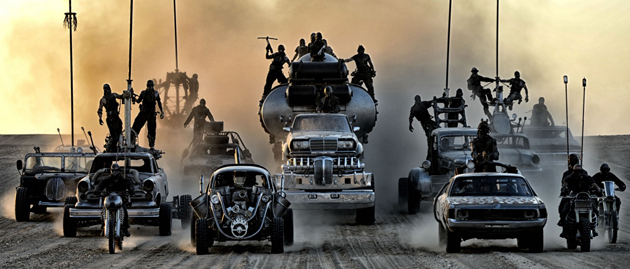Colin Gibson

versions of it that have to do something else but don’t do it very well because they have nothing to do with the object you invented in the first place. We wanted to control that and we wanted to put all the money and effort into the vehicles that were characters, actors that could do their own stunts. That way we don’t have to build four plastic versions of the one that had Velcro holding the seams together because we had actually built them to do what they needed to do.
AS: How many months of actual paid prep did you get?
CG: I wish you hadn’t said paid! It was basically a ten month process in Australia. But it varied- it was start and stop, studio and weather-dependent. It would start and we’d get five months and then we’d get another two. George was busy doing tap-dancing penguins and that kept him away from us for quite a while. Finally we got to a point where we were closing on a shoot date, and we went to Broken Hill where we were planning to shoot. P.J. Voeten, producer and first AD, Guy Norris the stunt coordinator and second unit action director, and myself and our teams all went and had a great time shooting and testing the vehicles. We then sent the footage back to George who suddenly realized we were almost ready to go.
AS: Did all these vehicles ultimately need to go to Africa?
CG: We built a bit of an airstrip in Mundi Mundi, which is in Broken Hill outside Silverton. It’s what we call the nearest outback to a city. But unfortunately the heavens opened up and the flowers carpeted the otherwise red desert and it turned into a beautiful horticultural miracle. You couldn’t swing a camera without seeing pelicans and camels dancing in the background. It was time to go back to where we had originally intended to shoot in 2003. We packed everything onto a very large boat and headed to Namibia.
AS: And this was a large amount of vehicles…
CG: It was just under a hundred-and-fifty. There were eighty-eight characters that we built. Trucks, tanks, cars, motorbikes, etc. But we had doubles, triples, quadruples, breakaways, and so on. Close to a hundred and fifty objects plus containers of weapons, props, and some of the wardrobe that had already been made. A lot of the wardrobe was fabricated in Africa under the lovely and talented Jenny Beavan, while we set up the new workshop. Stunts came over and almost immediately we started testing out in the new African conditions, which were a little different to what we designed for. The harder underfoot plains of Broken Hill gave way to sandy riverbeds an awful lot softer under the tire and there was another ten or fifteen degrees of heat. So there was a bit of reworking, reorganizing and re-purposing. Adding the odd radiator, a hundred foot of garden hose, additional suspension and somewhere to store the sunscreen.
AS: Did you work with local crews in Africa? Did you hire a team of people when you went out there?
CG: The first time we were in Africa we’d only taken three Australians and one New Zealander with us. Everyone else was local or South African. But this time around because we’d already built all the vehicles